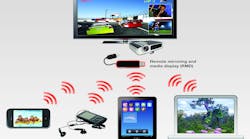Smartphones have become essential tools to many consumers—acting as a phone, camera, e-mail provider, schedule-keeper, and social-media enabler, among other things. Given that consumers are increasingly using their smartphones to take photos and videos, it is only natural that they should be enabled to easily share them with an audience via a bigger screen. Fulfilling this need is Miracast, the Wi-Fi Alliance’s Wi-Fi CERTIFIED certification program. Miracast makes it possible for users to instantly display video, pictures, and applications between certified devices from any brand—either at home or on the go.
Miracast relies on the Wi-Fi medium-access-control (MAC) and physical (PHY) layers. The vendor-specific user interface (UI) is used to manage the user inputs and preferences. Vendor-session policy management plays a key role as well—initiating device discovery and selection, authorizing the link between the source and display devices, storing the user profile, and managing traffic.
Because Miracast connections are formed using Wi-Fi Certified Wi-Fi Direct, access to a Wi-Fi network is not needed. The ability to connect rests inside the Miracast-certified devices. Those devices also provide simplified discovery and setup, which facilitates the sharing process. After initially pairing two Wi-Fi devices, users simply choose to stream content or mirror a display from one device (the source) to a second device (the display).
Because Miracast supports protected content streaming, devices can stream feature films and other copy-protected materials. To protect premium content, Miracast uses a wireless adaptation of content-protection mechanisms that are widely used for cabled interfaces, such as HDMI and DisplayPort. In addition, the latest WPA2 security protections are automatically enabled on every device. The transport of all multimedia content is therefore kept private.
The Miracast certification program was developed with the support of an ecosystem of silicon, mobile-device, and consumer-electronics (CE) vendors. The first products to be designated Wi-Fi Certified Miracast (which also form the test suite for the certification program) are the following: Broadcom dual-band 11n Wi-Fi; Intel WiDi; Marvell Avastar USB-8782 802.11n 1x1 dual-band reference design; MediaTek a/b/g/n dual-band mobile-phone client, MT662X_v1 and DTV Sink, MV0690; Ralink 802.11n wireless adapter, RT3592; and the Realtek dual-band 2x2 RTL8192DE HM92D01 PCIe half-mini card and RTD1185 RealShare smart display adapter. The first consumer products certified since testing opened to vendors include the LG Optimus G smartphone, Samsung Galaxy S III smartphone, and Samsung Echo-P Series TV.
Texas Instruments is already providing an end-to-end Miracast solution to deliver Wi-Fi-enabled digital-content streaming from mobile devices to other screens (see figure). The TI system, which comprises source and display (sink) solutions, is based on the multicore OMAP 4 processors, DaVinci video processors, and WiLink 6.0 and 7.0 connectivity solutions. It will soon be extended, however, to the OMAP 5 platform and WiLink 8.0 family. As an integrated near-field-communications (NFC) controller with Bluetooth v4.0, Global Navigation Satellite System (GNSS), and IEEE 802.11a/b/g/n, the WiLink 8.0 family promises to support all Wi-Fi throughput ranges using 2x2 multiple-input, multiple-output (MIMO) or single-input, single-output (SISO) at 40 MHz. It also will provide simple and quick NFC pairing to further simplify the setup process.
